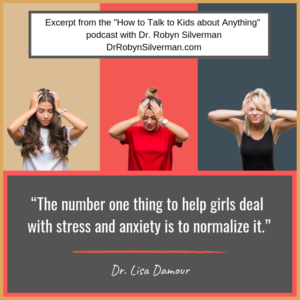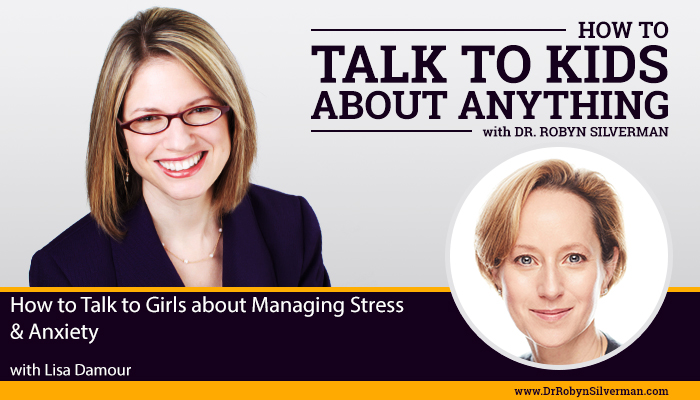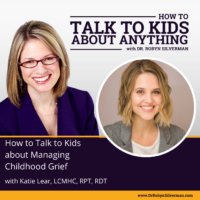Podcast: Play in new window | Download
Subscribe: Apple Podcasts | RSS | More
How to Talk to Girls About Managing Stress and Anxiety
This podcast will focus on how we can help girls manage stress and anxiety in productive ways. Anxiety in girls is on the rise- we need to help girls learn new strategies to cope with stress and anxiety. Often, anxiety and stress are healthy ways of showing that we need to pay attention to something—rather than a pathological problem we must obliterate. How can they best sort out complicated feelings? How can they better deal with conflict? How can adults serve as strong role models, sounding boards and a calming presence when anxiety is running high? Dr. Robyn Silverman talks with best-selling author, Dr. Lisa Damour, about how to talk to girls about managing stress and anxiety.
We have all seen the spikes in anxiety and stress in our young people these days. There is an unbelievable amount of pressure to  succeed, to look perfect, to be liked and to do it all. There are pressures at home, in school, within relationships and it feels heavy and constant. Now, though anxiety has risen among young people overall, studies confirm that it has skyrocketed in girls. What in the world is going on here? And what can we do about it? For the answers to these questions, we are turning to best-selling author, Dr. Lisa Damour.
succeed, to look perfect, to be liked and to do it all. There are pressures at home, in school, within relationships and it feels heavy and constant. Now, though anxiety has risen among young people overall, studies confirm that it has skyrocketed in girls. What in the world is going on here? And what can we do about it? For the answers to these questions, we are turning to best-selling author, Dr. Lisa Damour.
Lisa Damour writes the monthly adolescence column for the New York Times, serves as a regular contributor to CBS News, maintains a private psychotherapy practice, consults and speaks internationally, and is a Senior Advisor to the Schubert Center for Child Studies at Case Western Reserve University. Dr. Damour is the author of numerous academic papers, chapters, and books related to parenting and child development including her 2016 New York Times best seller, Untangled: Guiding Teenage Girls Through the Seven Transitions into Adulthood and now, Under Pressure: Confronting the Epidemic of Stress and Anxiety in Girls, comes out TODAY- lucky us- so welcome Dr. Lisa Damour to how to talk to kids about anything!
The podcast provides:
- Why we are seeing suck a spike in anxiety and stress in girls, especially.

- The top stressors for girls
- What healthy vs unhealthy stress looks like
- How to help girls sort out their feelings to avoid driving themselves crazy and doubting themselves
- How we can help girls manage their stress and anxiety (specific techniques)
- How to help our girls through meltdowns without joining in
- Different ways to look at disappointment
- A different way to look at social conflict between girls
- How to help girls sort out what’s really important
Important Messages:
- About 6-7 years ago, the word anxiety seemed to come to the forefront. It seemed like there was not a conversation with a girl, parent or teacher where that word did not come up. It hasn’t always been that way. What was happening? And what could we do to help?
- Boys tend to act out when under stress while girls tend to collapse in on themselves. There has always been these differences- but there has been such a spike in girls.
- Girls feel onstage almost everywhere they go. Academics, sports, volunteer work- wildly busy. While more comes on their plate, other things have not come off. And they need to pay attention to how they look. Cumulative force that plays a huge role in stress.
- Anxiety (when we need to be alert) and stress (when we are growing) are normal functions. Wholesale pathologizing of stress and anxiety- this has made things worse.
- Don’t avoid your anxiety- it can be a friend! It can tell you when you are uncomfortable and get out of there. But when we pathologize all anxiety, it makes them think that they need to make that anxiety go away- medicate, drink, etc.
- The world comes in three categories: Stuff we like, stuff that’s actually a crisis, and the in between—this is still the stuff we can handle. A lot of life falls into this third category! Life can sometimes FEEL that it falls into the first 2 categories—especially for upset teenagers. Say: “I totally get it. This is not your cup of tea but it’s definitely in the bucket of stuff that you can handle. It’s my job to help you figure out what it’s going to take to be able to handle this.”
- Controlled breathing can help control anxiety response. When we are anxious- we have a full body response that prepares us to fight or flee. Our heart and lungs speed up. The nerves are two-way streets. So if we breathe, we can slow down the breathe and then sends the message to the brain that all is well. The feeling of anxiety subsides. Slow and deep breathing. Hacks brain. Square breathing helps- 3 counts in, 3 counts hold, 3 counts out, 3 counts pause.
- Square breathing- as simple as it is, practice when you are calm so it becomes a well-warn groove. Just like a tennis player- with a lob in practice—practice so you have it in the game.
- Anxiety alerts us to threats on the outside and on the inside (things that happen and feelings on the inside).

- Girls messages- that they need to be happy and nice and transparent. You are allowed to be “brain annoyed” but you still need to be “behavior polite” to people. You have a front stage and backstage. This is a civil society. You can have private life—private emotional and psychological life. These are private feelings. You can feel jealous without expressing or acting on that jealousy. Thinking and feeling exist on a separate plane than doing- they don’t have to line up.
- Glitter jar- water and glitter to show what’s going on in the brain. “First we’re gonna settle your glitter.” It does 2 things at once- it models overwhelm in the brain- upgrades from primitive (emotional) to sophisticated (perspective). IN the teen years when everything is developing- the primitive section can be very powerful. Glitter storm- no clarity. It will fix itself on it’s own too. It provides instructions to the adult. Sit there calmly and let things settle- and show the girl that we are confident that things will settle on its own.
- It’s very helpful for a teen to see an adult look at them with confidence and know it will all be ok.
- Settle their glitter- go for a walk, keep company, have tea- what do they need to get the rational cortex back online? When it settles, the problem may be over or she can fix it.
- When we are firing questions at a girl about why this and why that when she is anxious—we are shaking the glitter jar.
- Young people don’t have the perspective. They’re young. There’s a sense that a misstep will mess up their whole trajectory.
- Be more transparent about our own path and our own challenges with anxiety and stress.
- If you are still talking about where you went to college after age 25, something went wrong. Where you went to college actually isn’t as important is what you do with your college education! Stop stressing so much about where you are going to go.
- If you put a bunch of teens together, there is going to be conflict. Now we just need to help them become good at them. Bulldozer- run people over. Doormat- get run over. Doormat with spikes- passive aggressive. The healthy form of conflict is “pillar.” That means that you stand up for yourself while being respectful of the other person. Play out the bulldozer, doormat with spikes or doormat- and then let the play out pillar so they can see the difference.
- Functioning adults don’t address all the frustrations with people. Is it worth it? Sometimes it’s not. It’s strategic to not engage in some conflicts- not important enough. Need to help girls understand that they don’t actually need to address ALL conflicts- some can drop! They can get distance. Are you comfortable will allowing that relationship go? Sometimes they just need help understanding how they can do that.
Notable Quotables:
- “About 6-7 years ago, the word anxiety seemed to come to the forefront. It seemed like there was not a conversation with a girl, parent or teacher where that word did not come up. It hasn’t always been that way.”
- “When girls are in distress, they, as a group, tend to collapse in on themselves. When boys are in distress, they tend to act out.”
- “Girls feel on stage almost everywhere they go.”
- “We are up against a culture that sends a very powerful message that female appearance matters tremendously.”
- “In our culture, there has been wholesale pathologizing about stress and anxiety—talking about all stress as toxic and all anxiety as if it were a disorder. Anxiety and stress are normal human functions. There is pathological anxiety and stress too. But when we pathologize ALL stress and anxiety, we actually make things worse. Then a girl comes home after a stressful day that all young people in school experience and she has two problems. She is stressed about her day and she is stressed because she feels stressed.”
- We need to teach girls to listen to their anxiety. “I’m anxious. This is my friend. What is it telling me? I need to pay attention to it.”
- “Girls receive the message that they must be transparent. We have to teach girls that thinking and feeling exist on a separate plane than doing- they don’t have to line up. That means that they can feel jealousy without acting on the jealousy. They can have a private emotional and psychological life and they decide who gets to hear that side of them.”
- “If you are raising a normally developing teenager, she will have meltdowns and there is nothing you can do to prevent that. It’s not a sign that she’s broken or you’re broken, it is a part of normal development.”
- “It’s tremendously helpful for young people to watch an adult watch them with total confidence that this is going to be okay.”
- “First, we need to help girls settle their glitter.”
- “Adult anxiety can be powerful when it comes to exacerbating a young person’s anxiety.”
- Instructions to the adults when anxiety is high in your daughter: “Just rest. And let your child see you not be frightened.”
- “The number one thing to help girls deal with stress and anxiety is to normalize it.”
- “Stress happens when we’re really pushing.”








